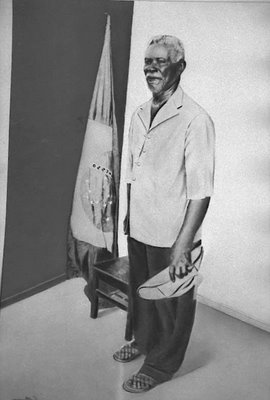

by Steven Mizrach
Santo Daime has been called a "new religion," it was actually founded back in the 1920s. A seven foot tall black rubber tapper living in the state of Acre named Raimundo Irineu Serra came into contact with indigenous groups who used the ayahuasca vine for contacting the spirit world. Serra was probably influenced both by Catholicism and also the Spiritism which was prevalent in Brazil at the time. While using the visionary vine, Serra met with a personage he called the Queen of the Forest, a white woman whom he identified with the Virgin Mary. (MacRae, 1992.)
The Queen of the Forest told Irineu to found a new religion with the ayahuasca tea as its main sacrament. He "channeled," many of the hymns which make up the liturgy of the new religion. "Daime" in Portuguese is not actually the name of a saint, as some people have thought. Instead, it means the imperative "give me."
The Queen of the Forest is worshipped as a teacher. But primarily its hymns and rituals are focused on the use of the Daime for enlightenment and healing. By the 30s, Santo Daime was gaining many adherents among Serra's fellow rubber-tappers and other rural Brazilians, and it spread to the town of Rio Branco. Eventually it even reached many of the major urban areas in Acre.
When Irineu died ,his successor, a man named Sebastiao Mota de Melo, moved in 1983 to a village named Ceu do Mapia ("the heaven of Mapia,") where 700 followers lived a communal existence centered around the Daime. This move had the paradoxical effect of attracting the interest of many Brazilian celebrities and metropolitan sophisticates, and these people, often to the consternation of the mostly poor and illiterate members living in Mapia, founded churches in major metropolitan centers, including this time Brazil's capital.
The Brazilian Federal Drug Council investigated the group, and to the surprise of many Brazilians, released a report claiming that the use of ayahuasca by the group posed no danger, and in fact had "positive beneficial" impacts on the community and on social integration. The government explicitly permitted the use of the plant by the religious , much in the same way that the U.S. authorized the use of the peyote cactus by the Native American Church. What followed next in the late 80s was a dramatic expansion of the Santo Daime sect overseas, with churches opening in Europe (especially Holland and Spain), the United States, and Japan, often being started initially by Brazilians travelling and living in those countries, but being joined by local New Agers and others.
This has caused some problems, again, because so far no other country besides Brazil has officially permitted the use of the ayahuasca vine for religious purposes, and in the U.S. and elsewhere harmine and harmaline (derivatives of the vine) are still controlled substances. Because it is a tropical woody liana, it's fairly difficult to grow in non-equatorial climates, except in climate-controlled greenhouses, so many of the international churches have to continue "importing" their sacrament from the mother country, which also runs into some thorny issues as well.
In Europe, the churches also attract the occasional celebrity, who either observes or participates in their ceremonies, and professes that they are "harmless."
Santo Daime is not the only ayahuasca-using sect in Brazil. There is actually another well-organized group known as the UDV or Uniao de Vegetal. This group calls ayahuasca simply "Hoasca" or "the Vegetable." They were founded by a mestizo named Jose Gabriel Costa in 1961, and use a mythology based on both the Old Testament and ancient Andean civilization. UDV is considerably more low-key than Santo Daime, and prefers to work with researchers and government agencies behind the scenes. Beginning in 1993, they began quietly working with ethnobotanists on studies of their sacred plant, which they called the Hoasca Project. In 1995, they held their first annual Hoasca Studies Conference, inviting researchers from all over the world to discuss new insights about the pharmacology and botany of their sacred plant. Between the UDV and Santo Daime, there are now probably anywhere between 10 and 20,000 Brazilians participating in ayahuasca-based religions.
Nenhum comentário:
Postar um comentário